Sanjeeb Dash
Obtaining Explainable Classification Models using Distributionally Robust Optimization
Nov 03, 2023



Abstract:Model explainability is crucial for human users to be able to interpret how a proposed classifier assigns labels to data based on its feature values. We study generalized linear models constructed using sets of feature value rules, which can capture nonlinear dependencies and interactions. An inherent trade-off exists between rule set sparsity and its prediction accuracy. It is computationally expensive to find the right choice of sparsity -- e.g., via cross-validation -- with existing methods. We propose a new formulation to learn an ensemble of rule sets that simultaneously addresses these competing factors. Good generalization is ensured while keeping computational costs low by utilizing distributionally robust optimization. The formulation utilizes column generation to efficiently search the space of rule sets and constructs a sparse ensemble of rule sets, in contrast with techniques like random forests or boosting and their variants. We present theoretical results that motivate and justify the use of our distributionally robust formulation. Extensive numerical experiments establish that our method improves over competing methods -- on a large set of publicly available binary classification problem instances -- with respect to one or more of the following metrics: generalization quality, computational cost, and explainability.
AI Hilbert: From Data and Background Knowledge to Automated Scientific Discovery
Aug 18, 2023Abstract:The discovery of scientific formulae that parsimoniously explain natural phenomena and align with existing background theory is a key goal in science. Historically, scientists have derived natural laws by manipulating equations based on existing knowledge, forming new equations, and verifying them experimentally. In recent years, data-driven scientific discovery has emerged as a viable competitor in settings with large amounts of experimental data. Unfortunately, data-driven methods often fail to discover valid laws when data is noisy or scarce. Accordingly, recent works combine regression and reasoning to eliminate formulae inconsistent with background theory. However, the problem of searching over the space of formulae consistent with background theory to find one that fits the data best is not well solved. We propose a solution to this problem when all axioms and scientific laws are expressible via polynomial equalities and inequalities and argue that our approach is widely applicable. We further model notions of minimal complexity using binary variables and logical constraints, solve polynomial optimization problems via mixed-integer linear or semidefinite optimization, and automatically prove the validity of our scientific discoveries via Positivestellensatz certificates. Remarkably, the optimization techniques leveraged in this paper allow our approach to run in polynomial time with fully correct background theory, or non-deterministic polynomial (NP) time with partially correct background theory. We experimentally demonstrate that some famous scientific laws, including Kepler's Third Law of Planetary Motion, the Hagen-Poiseuille Equation, and the Radiated Gravitational Wave Power equation, can be automatically derived from sets of partially correct background axioms.
Bayesian Experimental Design for Symbolic Discovery
Nov 29, 2022Abstract:This study concerns the formulation and application of Bayesian optimal experimental design to symbolic discovery, which is the inference from observational data of predictive models taking general functional forms. We apply constrained first-order methods to optimize an appropriate selection criterion, using Hamiltonian Monte Carlo to sample from the prior. A step for computing the predictive distribution, involving convolution, is computed via either numerical integration, or via fast transform methods.
Interpretable and Fair Boolean Rule Sets via Column Generation
Nov 16, 2021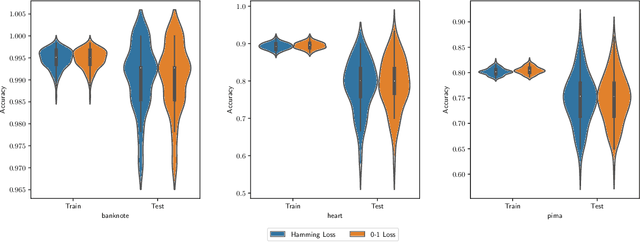
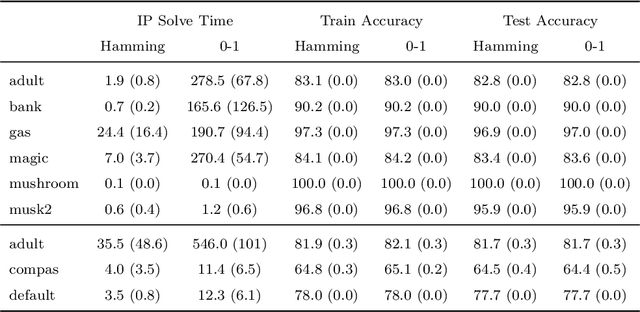

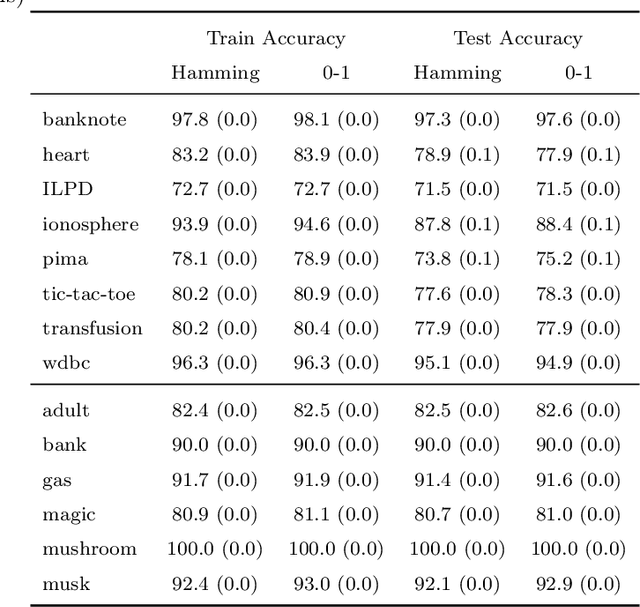
Abstract:This paper considers the learning of Boolean rules in either disjunctive normal form (DNF, OR-of-ANDs, equivalent to decision rule sets) or conjunctive normal form (CNF, AND-of-ORs) as an interpretable model for classification. An integer program is formulated to optimally trade classification accuracy for rule simplicity. We also consider the fairness setting and extend the formulation to include explicit constraints on two different measures of classification parity: equality of opportunity and equalized odds. Column generation (CG) is used to efficiently search over an exponential number of candidate clauses (conjunctions or disjunctions) without the need for heuristic rule mining. This approach also bounds the gap between the selected rule set and the best possible rule set on the training data. To handle large datasets, we propose an approximate CG algorithm using randomization. Compared to three recently proposed alternatives, the CG algorithm dominates the accuracy-simplicity trade-off in 8 out of 16 datasets. When maximized for accuracy, CG is competitive with rule learners designed for this purpose, sometimes finding significantly simpler solutions that are no less accurate. Compared to other fair and interpretable classifiers, our method is able to find rule sets that meet stricter notions of fairness with a modest trade-off in accuracy.
LPRules: Rule Induction in Knowledge Graphs Using Linear Programming
Oct 15, 2021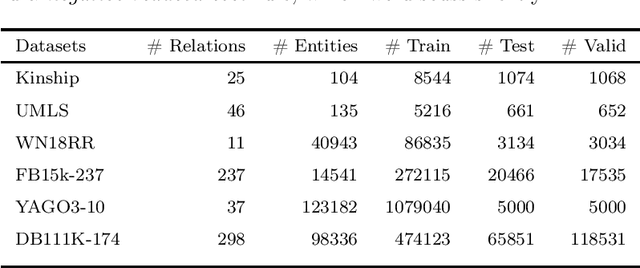
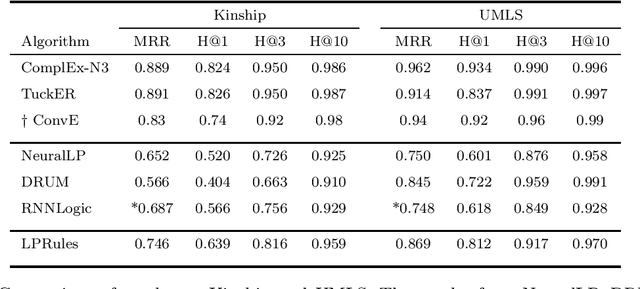
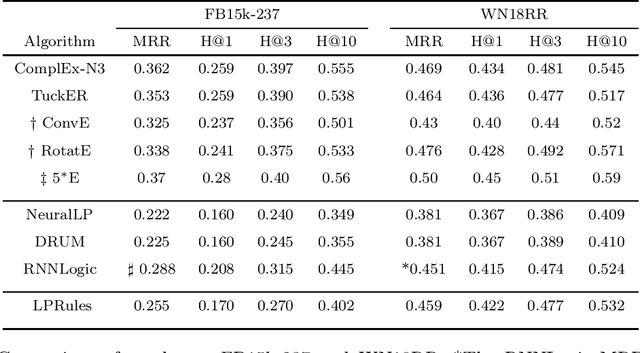
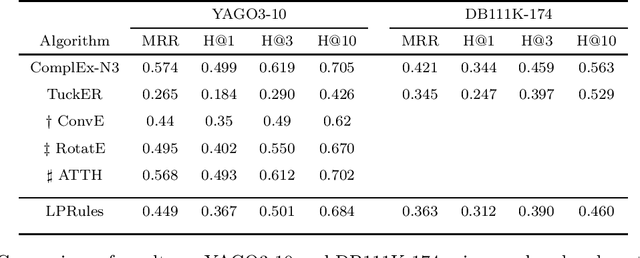
Abstract:Knowledge graph (KG) completion is a well-studied problem in AI. Rule-based methods and embedding-based methods form two of the solution techniques. Rule-based methods learn first-order logic rules that capture existing facts in an input graph and then use these rules for reasoning about missing facts. A major drawback of such methods is the lack of scalability to large datasets. In this paper, we present a simple linear programming (LP) model to choose rules from a list of candidate rules and assign weights to them. For smaller KGs, we use simple heuristics to create the candidate list. For larger KGs, we start with a small initial candidate list, and then use standard column generation ideas to add more rules in order to improve the LP model objective value. To foster interpretability and generalizability, we limit the complexity of the set of chosen rules via explicit constraints, and tune the complexity hyperparameter for individual datasets. We show that our method can obtain state-of-the-art results for three out of four widely used KG datasets, while taking significantly less computing time than other popular rule learners including some based on neuro-symbolic methods. The improved scalability of our method allows us to tackle large datasets such as YAGO3-10.
Integration of Data and Theory for Accelerated Derivable Symbolic Discovery
Sep 03, 2021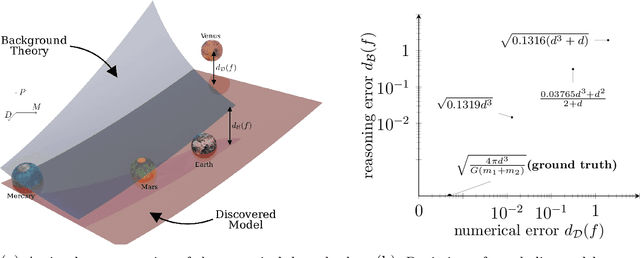
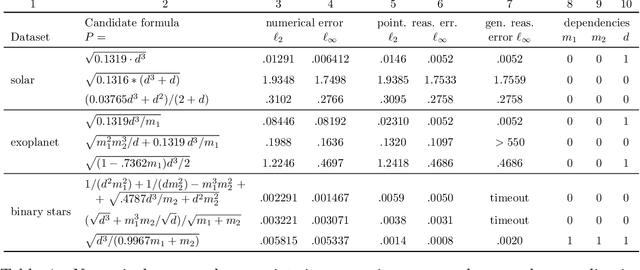

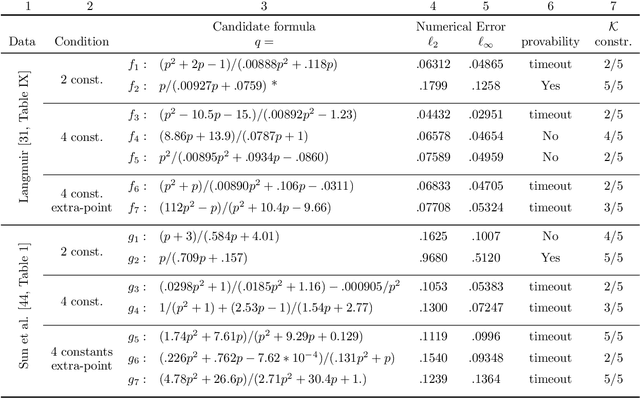
Abstract:Scientists have long aimed to discover meaningful equations which accurately describe data. Machine learning algorithms automate construction of accurate data-driven models, but ensuring that these are consistent with existing knowledge is a challenge. We developed a methodology combining automated theorem proving with symbolic regression, enabling principled derivations of laws of nature. We demonstrate this for Kepler's third law, Einstein's relativistic time dilation, and Langmuir's theory of adsorption, in each case, automatically connecting experimental data with background theory. The combination of logical reasoning with machine learning provides generalizable insights into key aspects of the natural phenomena.
Integer Programming for Causal Structure Learning in the Presence of Latent Variables
Feb 05, 2021


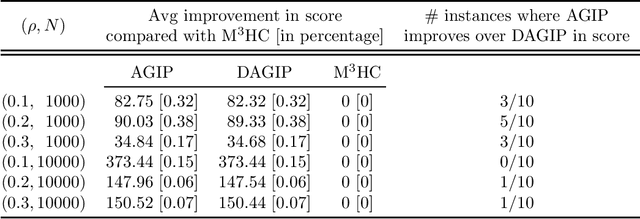
Abstract:The problem of finding an ancestral acyclic directed mixed graph (ADMG) that represents the causal relationships between a set of variables is an important area of research for causal inference. However, most of existing score-based structure learning methods focus on learning the directed acyclic graph (DAG) without latent variables. A number of score-based methods have recently been proposed for the ADMG learning, yet they are heuristic in nature and do not guarantee an optimal solution. We propose a novel exact score-based method that solves an integer programming (IP) formulation and returns a score-maximizing ancestral ADMG for a set of continuous variables. In particular, we generalize the state-of-the-art IP model for DAG learning problems and derive new classes of valid inequalities to formalize the IP-based ADMG learning model. Empirically our model can be solved efficiently for medium-sized problems and achieves better accuracy than state-of-the-art score-based methods as well as benchmark constraint-based methods.
Multilabel Classification by Hierarchical Partitioning and Data-dependent Grouping
Jun 24, 2020
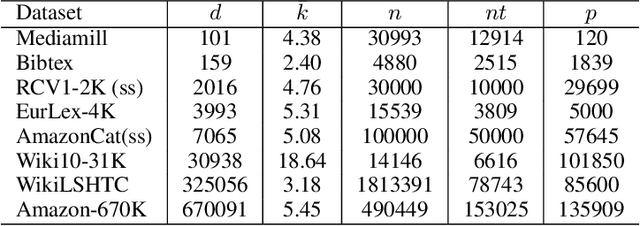
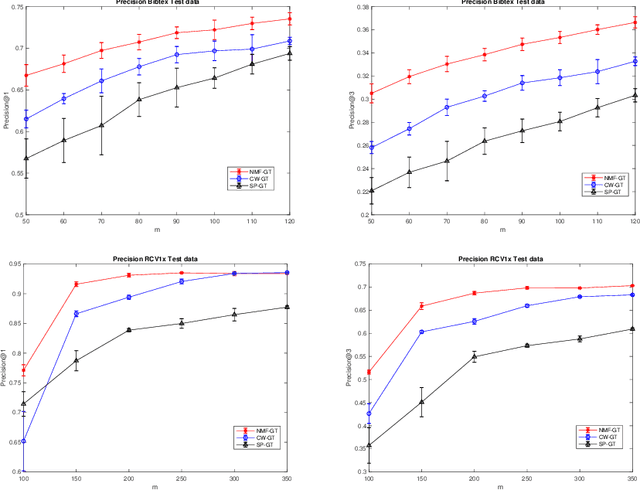
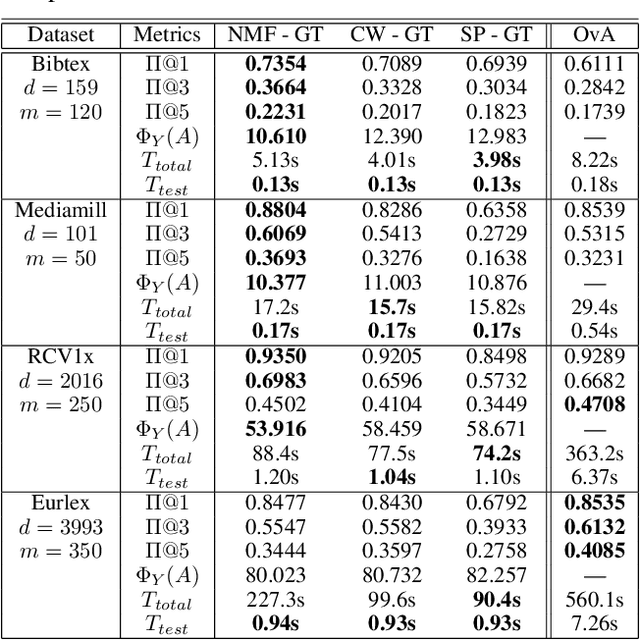
Abstract:In modern multilabel classification problems, each data instance belongs to a small number of classes from a large set of classes. In other words, these problems involve learning very sparse binary label vectors. Moreover, in large-scale problems, the labels typically have certain (unknown) hierarchy. In this paper we exploit the sparsity of label vectors and the hierarchical structure to embed them in low-dimensional space using label groupings. Consequently, we solve the classification problem in a much lower dimensional space and then obtain labels in the original space using an appropriately defined lifting. Our method builds on the work of (Ubaru & Mazumdar, 2017), where the idea of group testing was also explored for multilabel classification. We first present a novel data-dependent grouping approach, where we use a group construction based on a low-rank Nonnegative Matrix Factorization (NMF) of the label matrix of training instances. The construction also allows us, using recent results, to develop a fast prediction algorithm that has a logarithmic runtime in the number of labels. We then present a hierarchical partitioning approach that exploits the label hierarchy in large scale problems to divide up the large label space and create smaller sub-problems, which can then be solved independently via the grouping approach. Numerical results on many benchmark datasets illustrate that, compared to other popular methods, our proposed methods achieve competitive accuracy with significantly lower computational costs.
Symbolic Regression using Mixed-Integer Nonlinear Optimization
Jun 11, 2020
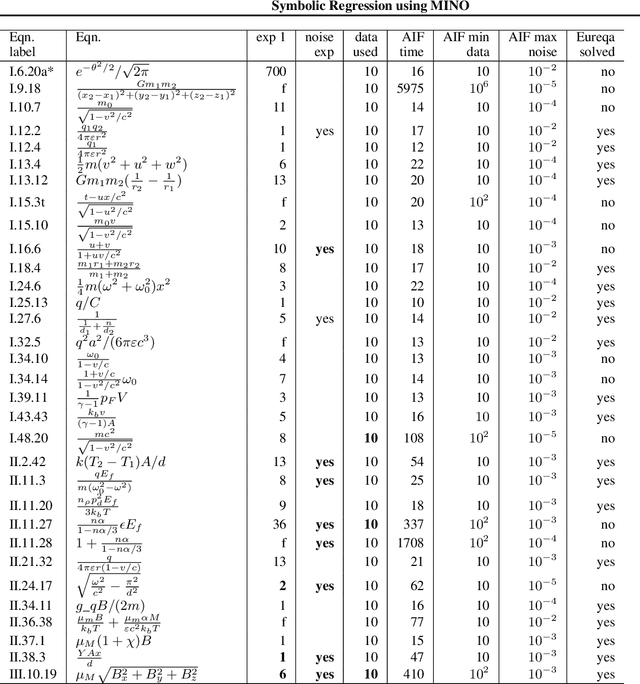
Abstract:The Symbolic Regression (SR) problem, where the goal is to find a regression function that does not have a pre-specified form but is any function that can be composed of a list of operators, is a hard problem in machine learning, both theoretically and computationally. Genetic programming based methods, that heuristically search over a very large space of functions, are the most commonly used methods to tackle SR problems. An alternative mathematical programming approach, proposed in the last decade, is to express the optimal symbolic expression as the solution of a system of nonlinear equations over continuous and discrete variables that minimizes a certain objective, and to solve this system via a global solver for mixed-integer nonlinear programming problems. Algorithms based on the latter approach are often very slow. We propose a hybrid algorithm that combines mixed-integer nonlinear optimization with explicit enumeration and incorporates constraints from dimensional analysis. We show that our algorithm is competitive, for some synthetic data sets, with a state-of-the-art SR software and a recent physics-inspired method called AI Feynman.
Generalized Linear Rule Models
Jun 05, 2019



Abstract:This paper considers generalized linear models using rule-based features, also referred to as rule ensembles, for regression and probabilistic classification. Rules facilitate model interpretation while also capturing nonlinear dependences and interactions. Our problem formulation accordingly trades off rule set complexity and prediction accuracy. Column generation is used to optimize over an exponentially large space of rules without pre-generating a large subset of candidates or greedily boosting rules one by one. The column generation subproblem is solved using either integer programming or a heuristic optimizing the same objective. In experiments involving logistic and linear regression, the proposed methods obtain better accuracy-complexity trade-offs than existing rule ensemble algorithms. At one end of the trade-off, the methods are competitive with less interpretable benchmark models.
 Add to Chrome
Add to Chrome Add to Firefox
Add to Firefox Add to Edge
Add to Edge